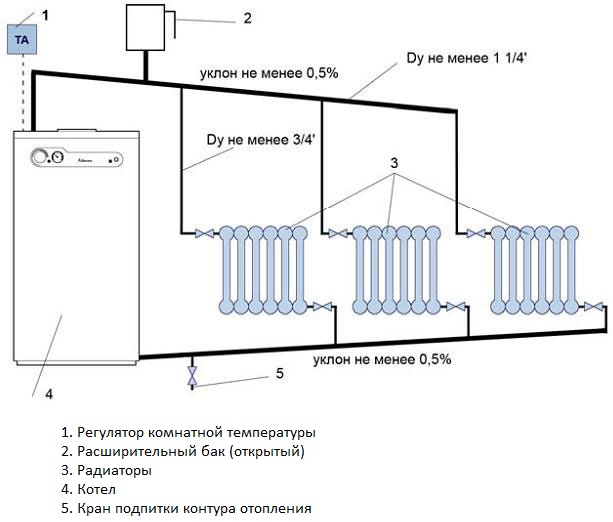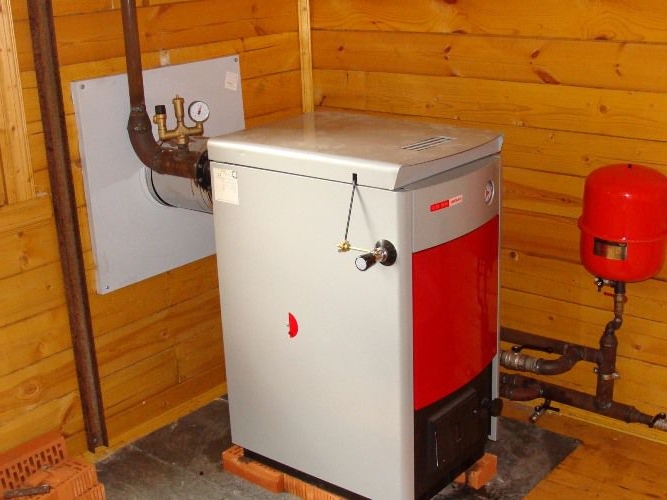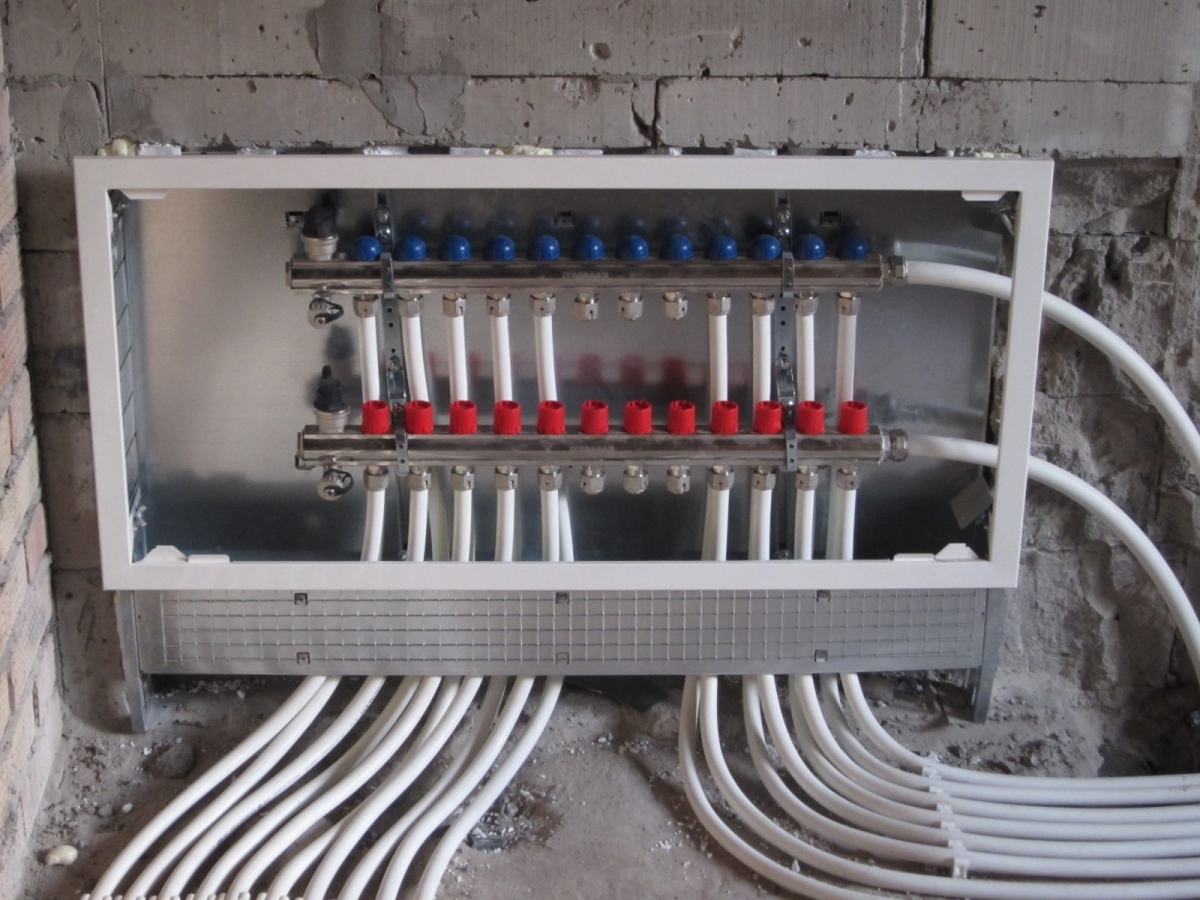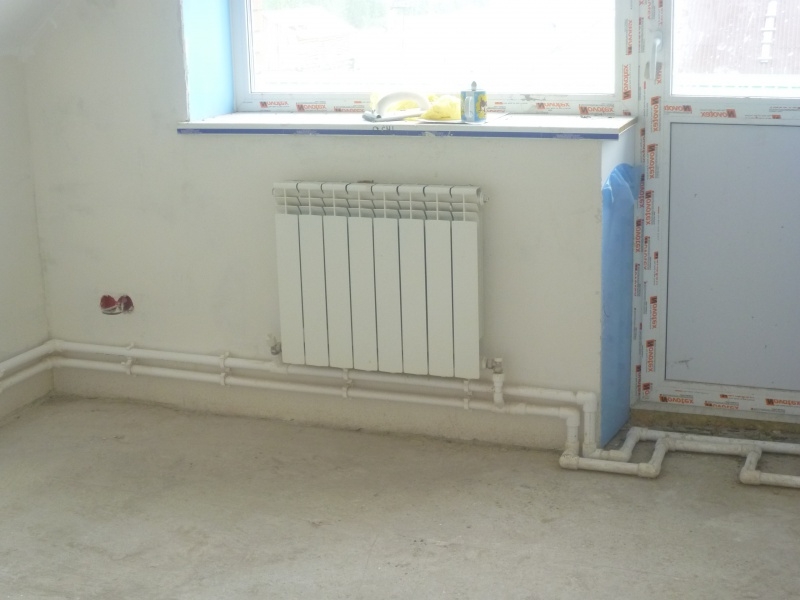Organizing heating with your own hands is a difficult task, but doable. This will require minimal knowledge of plumbing, as well as the skills of a welder and a builder. Indeed, to lay pipes, you will have to make holes in the walls, and solder the pipes themselves. For the rest, the main thing is to organize the process correctly!
Choosing a boiler for the heating system
The heating scheme does not depend on the type of boiler chosen, but it is a key element of the heating system in a private house. The correct choice will determine the cost of heating, boiler maintenance and the time for refueling.
Gas, solid fuel or electric?
The type of boiler depends on the availability of different types of fuel. So, the installation of a gas boiler is possible only if there is a gas main and a connection to it at home. This will require additional costs and obtaining permits, and the connection of the boiler to the heating system can only be done by a specialist. Such a boiler requires a ventilation system and a chimney.
Solid fuel boilers guarantee complete independence from external factors. But at the same time, you will have to organize a place for storing fuel, and loading the boiler takes a lot of time. After all, even long-burning boilers need to be loaded every 3 days. A chimney and ventilation are also needed.
The most inexpensive and easiest to use is electric. But electricity bills can scare off even very lazy owners. Such a boiler is suitable for a mild climate, a small house and, preferably, with solar panels and a wind turbine.
Single-circuit and double-circuit?
Double-circuit boilers perform two functions at once - they heat the room and heat the water. It is much more economical and does not require the installation of additional equipment. But in the summer, their use is unprofitable, the only way out is gas double-circuit boilers. They have the ability to turn off the heating circuit and work only in DHW mode.
With solid fuel boilers, you can get out of the situation by closing the heating circuit with taps. So the heat will be spent only on heating water, which significantly reduces fuel consumption. The only inconvenience is that the boiler needs to be loaded even in summer.
When using a single-circuit boiler, you will have to additionally install a boiler or a column, but in some cases such a scheme will be more profitable. For example, having also installed an indirect heating boiler, in the winter period the water heating will still be carried out by the boiler, saving electricity.
This difficult choice is batteries or underfloor heating
Another dilemma facing the owners of a private house is the choice of heating method. After all, both batteries and underfloor heating have their own advantages. For example, the installation of radiators is much simpler than a warm floor, but in terms of efficiency, the latter is much better.
Cast iron, steel or aluminum radiators?
Given the low pressure in the heating system of a private house, the choice of radiators is not limited by anything. Cast iron is durable, unpretentious to the quality of the coolant and pressure drops. But cast iron batteries cannot be used in thermoregulated systems, because they slowly heat up and cool down just as slowly.
Aluminum radiators can be considered universal. Their low price, fast heating and the ability to connect a thermostat make them very popular. But with increased alkalinity of water, there is a high chance of corrosion and leakage between sections.
The only drawback of steel batteries is the instability to water hammer, which does not happen in the system of a private house. At the same time, their low price, resistance to corrosion and fast heat transfer make them ideal for autonomous heating.
Advantages and disadvantages of a water-heated floor
The complexity of laying a water-heated floor makes it practically inaccessible for organizing with your own hands. But as a separate heating element, it is very convenient and relatively simple to implement. For example, in a bathroom, a heated floor will come in handy.
For such a solution, only collector wiring is suitable - the most technologically advanced, but also the most difficult to implement with your own hands. At the same time, warm floors may be contraindicated for health reasons, for example, with varicose veins. But for families with small children, underfloor heating is an ideal solution.
Heating schemes - one-pipe, two-pipe and collector
Diagram of a one-pipe heating system - economical, but inconvenient
A single-pipe heating system allows you to use the heating pipe as efficiently as possible - after all, only hot water flows along the entire perimeter. This option is suitable for small one-room summer cottages, because each next radiator will be colder than the previous one.
In addition, you will have to install a pump that provides forced circulation of the coolant. And this makes the house dependent on electricity, even if the boiler is running on solid fuel.
Two-pipe scheme - ease of installation and ease of use
If the goal is to make the house completely autonomous, you can arrange heating with natural circulation. But for this you will have to lay pipes with a slope of at least 0.05% so that air bubbles enter the open expansion tank, and the coolant itself circulates better.

Hot water rises to the desired height along the riser on its own, and on the floor the slope of the pipes should always be downward from the riser - this way the heated coolant will enter the radiators, and from them, already cooled down, into the boiler. For a two-story building, natural circulation is not always suitable, since the lower floors will always be colder than the upper ones.

The forced circulation scheme of a two-pipe system is much simpler. For organizing heating with your own hands, this is the best option, because pipes can be laid from the bottom along the wall and hidden in decorative panels. This does not require chipping the walls or pouring the floor over the pipes.

Collector circuit - keeping pace with progress
In this case, a collector is installed between the heating devices and the boiler. With its help, you can optimally distribute the coolant in each room, depending on the needs. But such a heating scheme is much more complicated and it can be carried out with your own hands only with experience.

Another drawback is its high cost due to the large amount of consumable material. Pipes, manifold cabinets, pumps and filters are essential elements of a manifold heating circuit. But this allows you to combine various heating devices and very accurately regulate the temperature in the rooms.
DIY heating installation
After choosing a heating scheme, calculating the amount of materials and purchasing heating equipment, it is installed. The correct order should be followed:
Boiler installation;
connection of the pump and other measuring devices near the boiler;
installation of a collector;
piping;
underfloor heating
installation of radiators;
connecting all heating devices and starting the system.
The boiler must be installed in a separate, ventilated room. The exception is electric boilers, which can be installed in residential premises, and gas boilers with a closed combustion chamber.

Wall-mounted models are attached to a special strip on the wall. It is forbidden to mount them directly on the wall. Floor-standing models are also installed on a stand - in the photo, a solid fuel boiler stands on a brick stand. The distances from walls and other objects specified in the passport must be observed, and the room itself is equipped in accordance with fire safety standards.

The circulation pump is connected after the boiler has been installed. If the selected model is equipped with an expansion tank and a safety group, they do not need to be installed separately. Also at this stage, boilers and backup boilers are installed, if they are provided for by the scheme.
Piping and underfloor heating
If a collector scheme is chosen, collector cabinets are installed, and only after that the heating pipes are divorced and laid. Installation of pipes along the walls allows you to significantly simplify the organization of home heating with your own hands. But in this case, the consumption of materials increases.

The device of underfloor heating is carried out in two ways - by concreting or by laying. In the first case, it will take up to 4 weeks for the concrete screed to dry, but the floor will warm up much faster.

It is much easier to use special plastic or wooden modules, but they are more expensive and the floors warm up more slowly. But in the event of malfunctions, it is much easier to disassemble such floors.
Batteries are installed under each window opening, and the number of sections is calculated depending on the size of the room. Radiators are mounted on brackets that are level. It is important to observe the distance - from the floor and windowsill at least 6-10 cm, from the wall about 5 cm.

Connection to heating pipes is made after installing the battery on the brackets. The connection is made using adapters, so it is not necessary to adjust the wiring to the hole pattern. In addition, the elements of the piping to the radiators should have a slope of 0.5 cm towards the circulation for each meter of the pipe. Otherwise, the accumulated air in the battery will have to be blown out manually.
![]()
Outcomes
The simplest in execution is a two-pipe heating system with forced circulation and installed radiators. But still, for those who have never encountered the installation of a heating system and do not have construction skills, it is better to turn to specialists.
At the same time, one should not forget to control the performers! Everything that a novice "builder" needs to know for the correct organization of the heating system is described in the video:



